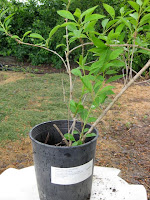It's a nice spring Saturday. You decide to do a little shopping, perhaps picking something up for the garden. Off you go to the big box store, the local nursery or (gulp!) the local drugstore or supermarket (which, you may have noticed lately, has that alluring display of colorful annuals and vegetables outside the front door).
You got everything together so you can get out of the driveway...keys, credit, cash, a coffee. Um, wait a minute, before you leave the house...
Do you have any frickin' idea what you are going to buy? No?
You, then, will be crowned "Garden Customer of the Day" wherever you shop. That's because you'll be impulse buying, spending more money on plants that may or may not be right for you and your yard.
But this rant isn't about your shopaholic ways. Another day for that (hint: survey the yard for your needs; make a list or garden plan; stick to it).
No, this rant is about something every gardener should carry in their car and grab it when they walk into a nursery section: a good plant reference book.
Updating your old Sunset Western Garden Book? Fine. Put the old one in the car trunk.
Also, look for the Northeastern Garden Book or the National Garden Book (if you can still find them!)
or the National Garden Book (if you can still find them!)
Why approach a place of business that's selling plants with such a reference book?
Here are three, early spring shopping scenarios that, unfortunately, are too common that may fool unsuspecting gardeners:
 |
| Summer vs. Winter: Marigolds next to Violas |
1) an eye-catching rack of annuals and vegetables outside the front door of supermarkets and drugstores. Those plants may be there either a) too late in the season; b) too early in the season; or, c) mixed together so that you can't tell whether they are cool season or warm season annuals.
2) mismarked signs.
 |
| Azaleas? How about...an invasive Scotch Broom! |
 |
| Thanks to eagle-eye Trey Pitzenberger for spotting this! |
3) mismarked pots.
 |
| Forsythia (6' tall) in a can marked... |
 |
| Iberis (6" tall) |
In all of these instances, a good reference book while plant shopping can help you answer such questions as:
• Is the plant I am looking at REALLY that plant? (compare it to the plant description in the book).
• When is the best growing season for this plant?
• Do I really want this particular variety of plant? (For example, a Beefmaster tomato can offer up large slicing tomatoes all summer; a Roma tomato, though, tends to set smaller fruit all at once which makes it ideal for canning purposes)
• Do I have the right spot in my yard for this plant: Does it require sun or shade? Quick draining soil? Lots of water or little water? Acid soil? Are any of its parts poisonous?
I realize that "sticking to a garden plan" is, well...challenging, especially when you meet up with a comely beauty at a nursery. Still, arming yourself with a good reference book while nursery shopping might give you more incentive to drive home, alone.
Too bad Sunset doesn't publish such a book for "Singles Bars" hobbyists.
Too bad Sunset doesn't publish such a book for "Singles Bars" hobbyists.
Do you have a favorite plant reference book? Leave a comment!





Hi Fred:
ReplyDeleteLike cooking and beekeeping, gardening is hobby where there are at least five opinions to answer every one question. For a self-labeled beginner, I really appreciate your consistent advice from week to week; for example, be patient, read and follow the label instructions, and trust the Sunset Western Garden Book. I listen to your radio podcasts every week on both stations and appreciate them very much as I live in San Jose and there are scarce radio gardening shows in the SF Bay Area.
I know I can do the research, but would you happen to know if the Sunset Western Garden Book comes in a PDF or Kindle option? I find that precious few "green" books are offered in the paperless and earth-friendly PDF or e-book reader options.
Thanks!
Donald
This is why I keep my iPhone handy at all times. I have Botany Buddy installed on it as well as full access to the Internet where I check EVERYTHING. Yeah, I'm a slow shopper due to all the fact-checking.
ReplyDeletePeople really sell Scotch Broom? I think I'd accidentally have to spill a whole bottle of herbicide on that display. How freakin irresponsible! Can't tell you how many hours I've spent removing that stuff from public lands. Man that makes me mad!
ReplyDeleteI've got a neighbor who put not one -- but THREE Scotch Brooms in her front yard. They look nice now -- sure they do. Just wait another couple of years. Fortunately -- for them? They're moving. The new owner will get to find out about the horrors of Scotch Broom....
ReplyDeleteWait a minute. They SELL Scotch Broom?! Nevada County is getting state or fed money to get rid of it. Maybe I'll dig some up and sell it out of the back of my car down there.
ReplyDeleteNot really. That stuff should be illegal.
As far as reference books go, the Western Nevada County Gardening Guide is a must-have here in the foothills.
ReplyDeleteJust for the record, the plant shown is Cytisus spachianus, aka Easter broom, which is not specifically considered invasive although "the jury is out" according to the CIPC.
ReplyDeleteScotch broom, Cytisus scoparius, which is very invasive, has reduced leaves and looks much more like a broom.
This yellow blooming plant you show here has always caught my eye when plant shopping and I'm sure I have almost purchased one. I'm glad I've read this - now I will steer clear of it. Thanks for posting this.
ReplyDelete